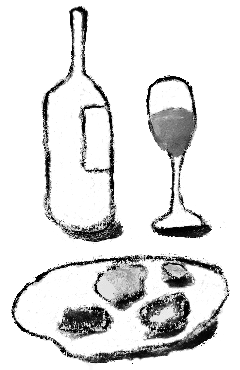
The pine nut (pinhão) was food from childhood when I lived in Rio Grande do Sul. Seed of the Araucária (Araucaria angustifolia), native tree of Brazil and found in the Atlantic Forest and the Pampa, pine nut has always been synonymous with winter, Junina festivities, conversations in front of the fireplace. Something you ate simply because you were together, as a group, as a family.
Eating pine nuts was also to remove its bark with the teeth, seeking seeds that were still left in the tangle of shells that were accumulating on the plate. This was a habit that I incorporated absolutely. After going living in Santa Catarina, I bought a pine nut peeler. I figured I wouldn’t dispense with its use anymore. In fact, I used it a couple of times and got back into the habit of peeling pinhao with my teeth. It seems that eating this way tastes different.
But pine nut is not only part of my history with food. Boiled in water, baked on a stove or fired directly on fire, this seed has been a staple food for many communities over the centuries, especially for indigenous peoples of Brazil. The Araucária, besides having an average life of 200 to 300 years, can reach up to 50 meters high. For this reason, the most suitable way to obtain the pine nut is to wait for the pine cone to fall from the tree. This also ensures that the seed is ripe for consumption.
At this time, when we do not know exactly when, where and how most of what we eat is produced, there are some foods that remind us of an almost lost seasonality. The pinion is one of them. Between the months of April and July, you can find it in several shops.
In Santa Catarina, the second state with the highest pine nut production in the country, the araucaria not only demarcate the landscape of the mountainous region; as occurs in other southern and southeastern states this seed is a source of income for many families that keep up from their extraction.
In addition to providing food, Araucaria is still linked to the survival of many species of fauna and flora, which also means maintaining the balance of the ecosystem. Both in Santa Catarina and in other producing states of Brazil, this species is threatened with extinction, as a result of the exploitation of its wood for the production of furniture, pulp and paper, and also the advancement of agribusiness.
The threats to the survival of the araucaria in the coming decades represent much more than the risk of the next generations not being able to enjoy pine nuts. Its preservation is essential for maintaining the environmental balance and biodiversity, which also means ensuring the future of the next generations.
Pinhão não é só comida do passado
O pinhão era comida da infância desde quando eu vivia no Rio Grande do Sul. Semente da araucária (Araucaria angustifolia), árvore nativa do Brasil e encontrada na Mata Atlântica e no Pampa, pinhão sempre foi sinônimo de inverno, festa junina, conversas em frente à lareira. Algo que se comia simplesmente porque se estava junto, em grupo, em família.
Comer pinhão era também tirar sua casca com os dentes, buscar sementes que ainda restavam no emaranhado de cascas que iam se acumulando no prato. Esse foi um hábito que incorporei absolutamente. Depois de vir morar em Santa Catarina, comprei um descascador de pinhão. Imaginei que não prescindiria mais de seu uso. Na verdade, usei umas duas vezes e voltei ao hábito de tirar as cascas com os dentes. Parece que comendo desse modo o sabor é outro.
Mas pinhão não é parte somente da minha história com a comida. Cozido em água, assado na chapa do fogão a lenha ou ateado diretamente ao fogo, essa semente foi um alimento fundamental para muitas comunidades ao longo dos séculos, especialmente para povos indígenas. A araucária, além de possuir uma média de vida de 200 a 300 anos, pode chegar até 50 metros de altura. Por essa razão, a maneira mais adequada de obter o pinhão é esperar que a pinha caia da árvore. Isso também garante que a semente esteja madura para o consumo.
Nesta época, em que não sabemos exatamente quando, onde e como é produzida a maior parte do que comemos, existem alguns alimentos que nos recordam de uma sazonalidade quase perdida. O pinhão é um deles. Entre os meses de abril e julho, é possível encontrá-lo em diversos comércios.
Em Santa Catarina, segundo estado de maior produção de pinhão do país, as araucárias não apenas demarcam a paisagem da região serrana; assim como ocorre em outros estados do sul e sudeste produtores de pinhão, essa semente é uma fonte de renda para muitas famílias que se mantêm a partir do seu extrativismo.
Além de fornecer um alimento, a araucária ainda está ligada à sobrevivência de muitas espécies da fauna e da flora, o que também significa manutenção do equilíbrio do ecossistema. Tanto em Santa Catarina quanto em outros dos estados produtores, esta espécie está ameaçada de extinção, em consequência da exploração da sua madeira para a produção de móveis, celulose e papel, e ainda do avanço do agronegócio.
As ameaças à sobrevivência das araucárias nas próximas décadas representam muito mais do que o risco de as próximas gerações não poderem desfrutar dos pinhões. Sua preservação é essencial para a manutenção do equilíbrio ambiental e da biodiversidade, o que também significa garantir o futuro das próximas gerações.










